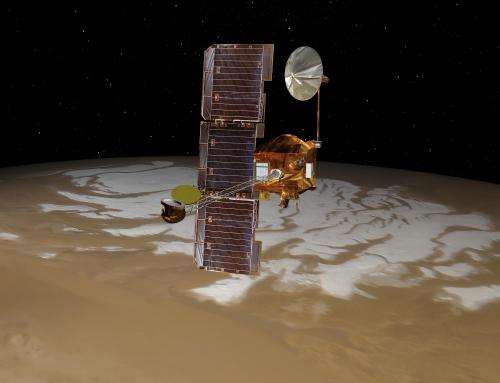Long-lived Mars Odyssey orbiter resumes work with fresh equipment

(Phys.org)—The NASA Mars Odyssey orbiter has resumed duty after switching to a set of redundant equipment, including a main computer, that had not be used since before the spacecraft's 2001 launch.
Odyssey relayed data to Earth late Sunday that it received from NASA's Opportunity rover on Mars using the orbiter's fresh "B-side" radio for UHF (ultra-high frequency) communications. In plans for this week are relay opportunities for the newest Mars rover, Curiosity, and resumption of Odyssey's own scientific observations.
"The side-swap has gone well. All the subsystems that we are using for the first time are performing as intended," said Odyssey Project Manager Gaylon McSmith of NASA's Jet Propulsion Laboratory, Pasadena, Calif.
Like many spacecraft, this orbiter carries a pair of redundant main computers, to have a backup available if one fails. Odyssey's A-side computer and B-side computer each have several other redundant subsystems linked to just that computer.
Odyssey is already the longest-working spacecraft ever sent to Mars. The side swap was initiated last week in response to months of diagnostic data indicating that the A side's inertial measurement unit shows signs of wearing out. This gyroscope-containing mechanism senses changes in the spacecraft's orientation, providing important information for control of pointing the antenna, solar arrays and instruments.
The diagnostics indicate that the A side's inertial measurement unit still has a few months or more of useful life. The reason for switching sides was to keep a fully functional A side available in case of any problem on the B side in coming years that can be dealt with by switching back to the A side temporarily for a few days or weeks.
"It is testimony to the excellent design of this spacecraft and operation of this mission in partnership with Lockheed Martin that we have brand-new major components available to begin using after more than 11 years at Mars," McSmith said.
JPL, a division of the California Institute of Technology in Pasadena, manages the Mars Odyssey project for NASA's Science Mission Directorate in Washington. Lockheed Martin Space Systems in Denver built the spacecraft. JPL and Lockheed Martin collaborate on operating the spacecraft.
The Mars Reconnaissance Orbiter, which shares with Odyssey the data-relay responsibility for NASA's Mars rovers, continued relay support while Odyssey was unavailable for a few days following the side swap.
Odyssey launched April 7, 2001, began orbiting Mars Oct. 24 that year, began systematic science observations of Mars in early 2002, and broke the previous record for longest-working Mars spacecraft in December 2010. Odyssey's longevity enables continued science by instruments on the orbiter, including the monitoring of seasonal changes on Mars from year to year, in addition to communication-relay service. For more about the Mars Odyssey mission, visit: mars.jpl.nasa.gov/odyssey" target="_blank">mars.jpl.nasa.gov/odyssey .
Provided by JPL/NASA





















